Life Expectancy
Last Modified 30/01/2024 15:41:14
Share this page
Introduction
Life expectancy is one of the key indicators of health in a population. Life expectancy at birth is defined as the average number of years that a newborn is expected to live if current mortality rates continue to apply. Life expectancy for men in Blackpool is 73.4 years and for women is 79.0 (2020-2022), both lower than national averages. There are considerable differences in life expectancy within Blackpool. Men in the least deprived areas of the town can expect to live 13.2 years longer than men in the most deprived areas. Similarly, for women this difference is 9.5 years. Not only do people in Blackpool live shorter lives, but they also spend a smaller proportion of their lifespan in good health and without disability (Figures 5 and 6).
Blackpool faces major health challenges. The early 2000s saw a steady improvement in life expectancy, dropping in 2013-15 before levelling off until 2017-19. However, the gap between Blackpool and the rest of England continues to grow (Figure 1 and 2). Life expectancy fell for both males and females from 2020 onwards, a trend also reflected nationally as the country was impacted by Covid-19. Blackpool saw increased mortality as a result of Covid-19 from April 2020.
Both men and women in Blackpool have the lowest life expectancy from birth of any local authority in England. Blackpool's life expectancy is 5.4 years below England and 3.9 years below the North West in Males. Female life expectancy is 3.8 years below England & Wales and 2.4 years below the North West female life expectancy from birth (2020-22).
Figure 1 - Life Expectancy at Birth (1991-93 to 2020-22)
 Source: Office for National Statistics (ONS), Life expectancy at birth (years)
Source: Office for National Statistics (ONS), Life expectancy at birth (years)
Figure 2 - Life expectancy at birth table (1991-93 to 2020-22)
| | MALES | FEMALES |
|---|
| | England | North West | Blackpool | England | North West | Blackpool |
|---|
| 1991-93 |
73.6 |
72.4 |
71.6 |
79.1 |
77.9 |
78.3 |
|---|
| 1992-94 |
73.9 |
72.7 |
71.5 |
79.3 |
78.1 |
78.6 |
|---|
| 1993-95 |
74.1 |
72.8 |
71.0 |
79.4 |
78.3 |
78.0 |
|---|
| 1994-96 |
74.3 |
73.1 |
71.5 |
79.6 |
78.5 |
77.7 |
|---|
| 1995-97 |
74.5 |
73.2 |
71.6 |
79.6 |
78.5 |
77.3 |
|---|
| 1996-98 |
74.7 |
73.4 |
72.1 |
79.8 |
78.5 |
77.4 |
|---|
| 1997-99 |
75.0 |
73.6 |
72.2 |
79.9 |
78.6 |
77.9 |
|---|
| 1998-00 |
75.3 |
73.9 |
72.2 |
80.1 |
78.9 |
78.2 |
|---|
| 1999-01 |
75.6 |
74.2 |
72.0 |
80.3 |
79.1 |
78.4 |
|---|
| 2000-02 |
75.9 |
74.6 |
71.7 |
80.6 |
79.4 |
78.4 |
|---|
| 2001-03 |
76.1 |
74.8 |
72.0 |
80.7 |
79.4 |
78.4 |
|---|
| 2002-04 |
76.4 |
75.1 |
72.8 |
80.8 |
79.7 |
78.4 |
|---|
| 2003-05 |
76.8 |
75.4 |
73.2 |
81.1 |
79.9 |
78.8 |
|---|
| 2004-06 |
77.2 |
75.7 |
73.3 |
81.5 |
80.3 |
78.7 |
|---|
| 2005-07 |
77.5 |
76.0 |
73.2 |
81.7 |
80.5 |
79.0 |
|---|
| 2006-08 |
77.8 |
76.3 |
73.5 |
82.0 |
80.6 |
78.8 |
|---|
| 2007-09 |
78.1 |
76.6 |
73.7 |
82.2 |
80.8 |
79.4 |
|---|
| 2008-10 |
78.5 |
77.0 |
73.6 |
82.5 |
81.1 |
79.4 |
|---|
| 2009-11 |
78.8 |
77.4 |
73.8 |
82.8 |
81.5 |
80.0 |
|---|
| 2010-12 |
79.1 |
77.6 |
74.0 |
82.9 |
81.6 |
79.9 |
|---|
| 2011-13 |
79.3 |
77.8 |
74.3 |
83.0 |
81.7 |
80.1 |
|---|
| 2012-14 |
79.4 |
78.0 |
74.7 |
83.1 |
81.8 |
80.0 |
|---|
| 2013-15 |
79.5 |
78.1 |
74.4 |
83.1 |
81.8 |
79.5 |
|---|
| 2014-16 |
79.5 |
78.1 |
74.4 |
83.1 |
81.7 |
79.5 |
|---|
| 2015-17 |
79.5 |
78.2 |
74.4 |
83.1 |
81.7 |
79.7 |
|---|
| 2016-18 |
79.6 |
78.3 |
74.7 |
83.2 |
81.9 |
79.6 |
|---|
| 2017-19 |
79.7 |
78.4 |
74.7 |
83.3 |
82.0 |
79.7 |
|---|
| 2018-20 |
79.4 |
77.9 |
74.4 |
83.1 |
81.7 |
79.2 |
|---|
| 2019-21 |
79.0 |
77.5 |
73.7 |
82.9 |
81.5 |
79.3 |
|---|
| 2020-22 |
78.9 |
77.3 |
73.4 |
82.8 |
81.3 |
79.0 |
|---|
Source: Office for National Statistics, Life expectancy at birth (years)
Variation in Life Expectancy within Blackpool
There is geographical variation within Blackpool (Figures 3 and 4) with male life expectancy ranging from 67.3 years in Bloomfield, to 80.5 years in Marton - a difference of 13.2 years. Female life expectancy ranges from 73.6 years in Claremont to 83.0 years in Stanley, a difference of 9.5 years.
Figure 3 - Male and Female Life Expectancy by Ward, Blackpool (2016 - 2020)
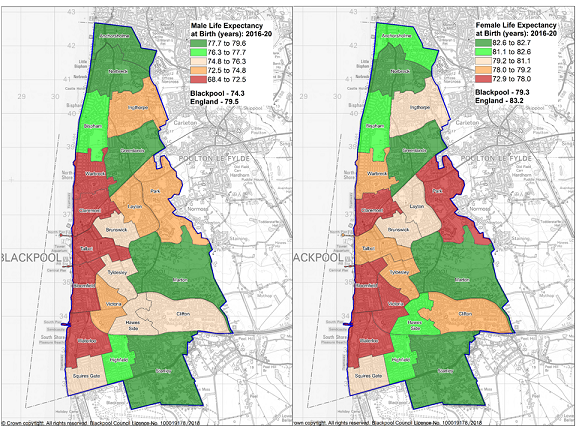 Source: OHID, Local Health
Source: OHID, Local Health
Healthy Life Expectancy
Whereas life expectancy (LE) is an estimate of how many years a person might be expected to live, healthy life expectancy (HLE) is an estimate of how many years they might live in 'good' health. The HLE estimate was calculated using self-reported prevalence of 'Good' general health collected in the Annual Population Survey. Comparisons of HLE between England and Blackpool show a greater difference than for LE alone.
From this it can be observed that residents of Blackpool live shorter lives than the national average, and furthermore spend a smaller proportion of their shorter lifespan healthy and disability-free (Figures 4 and 5). Healthy Life Expectancy for both men and women in the country is the lowest of all local authorities in England, and HLE for women in Blackpool reduced from 57.1 between 2016 and 2018 to 54.29 between 2018 and 2020.
Figure 4 - Male Life expectancy and Healthy Life Expectancy, Upper Tier Local Authority (2018 - 2020)
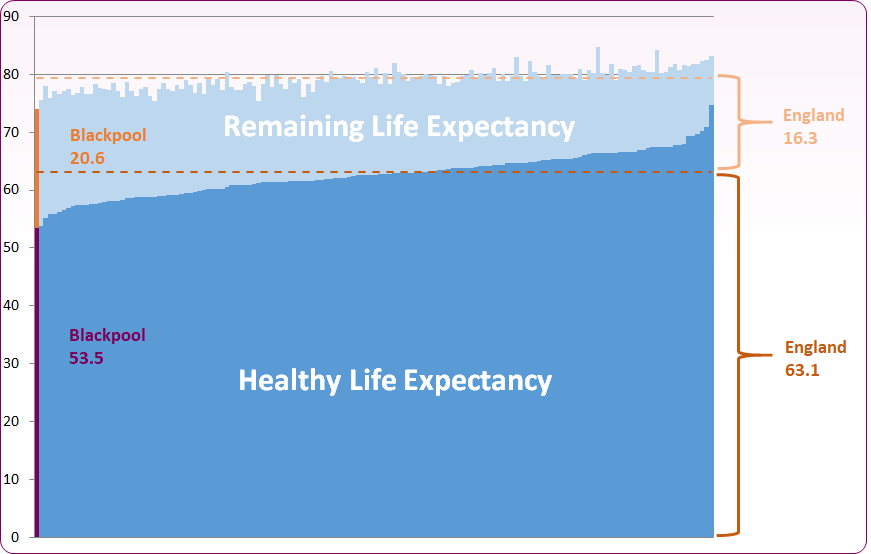 Source: ONS, Healthy Life Expectancy
Source: ONS, Healthy Life Expectancy
Figure 5 - Female Life expectancy and Healthy Life Expectancy, Upper Tier Local Authority (2018 - 2020)
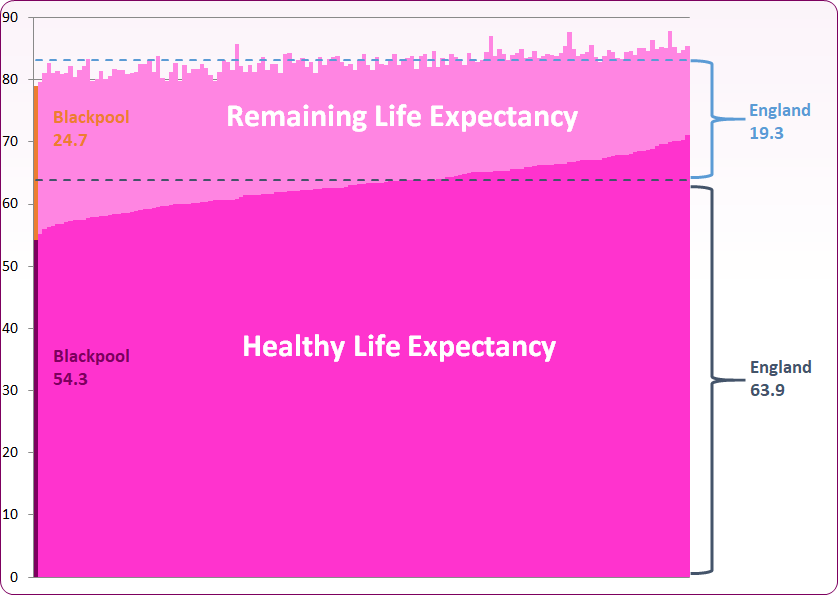 Source: ONS, Healthly Life Expectancy
Source: ONS, Healthly Life Expectancy
Inequalities also exist within Blackpool for healthy life expectancy and disability free life expectancy. According to 2009-2013 ward-level data, it is estimated that in Blackpool's most affluent ward (Norbreck), a man might live in 'good' health until the age of 63.3, compared to just 47.1 in the most deprived ward (Bloomfield) (Figure 6). Variation in healthy life expectancy also exists in females, with females in Bloomfield ward living on average to 51.2 in 'good' health compared to 63.8 in Stanley ward (Figure 7)1. There is also variation in the disease groups affecting more deprived areas of Blackpool, compared to England as a whole.
Figure 6 - Male Life Expectancy and Healthy Life Expectancy at Birth - Blackpool wards (2009-2013)
 Source: ONS, Healthly Life Expectancy
Source: ONS, Healthly Life Expectancy
Figure 7 - Female Life Expectancy and Healthy Life Expectancy at Birth - Blackpool wards (2009-2013)
 Source: ONS, Healthy Life Expectancy
Source: ONS, Healthy Life Expectancy
Understanding variations in Life Expectancy
Figure 8 shows the causes of mortality that contribute to the life expectancy gap between the 20% most deprived communities in Blackpool and the 20% least deprived communities in Blackpool, by cause of death for the COVID-19 affected period 2020-21. Deaths in younger people, especially in babies, contribute to a larger proportion of the gap, as more years of life are lost. The largest difference in life expectancy between the most and least deprived communities for males is due to deaths from external causes, that is deaths from injuries, poisonings and suicide, which account for 30.4%. For females it is circulatory diseases (including coronary heart disease and stroke) (27.3%) and cancer (20.9%). This has changed since 2015-17 when the largest difference was respiratory diseases (including flu, pneumonia and chronic lower respiratoy disease) (21.7%) followed by circulatory diseases (21.6%) and cancer (16.3%).
Figure 8 - Scarf Chart showing the breakdown of the life expectancy gap between the most deprived quintile in Blackpool and the least deprived quintile in Blackpool, by cause of death, 2020-2021 (provisional)
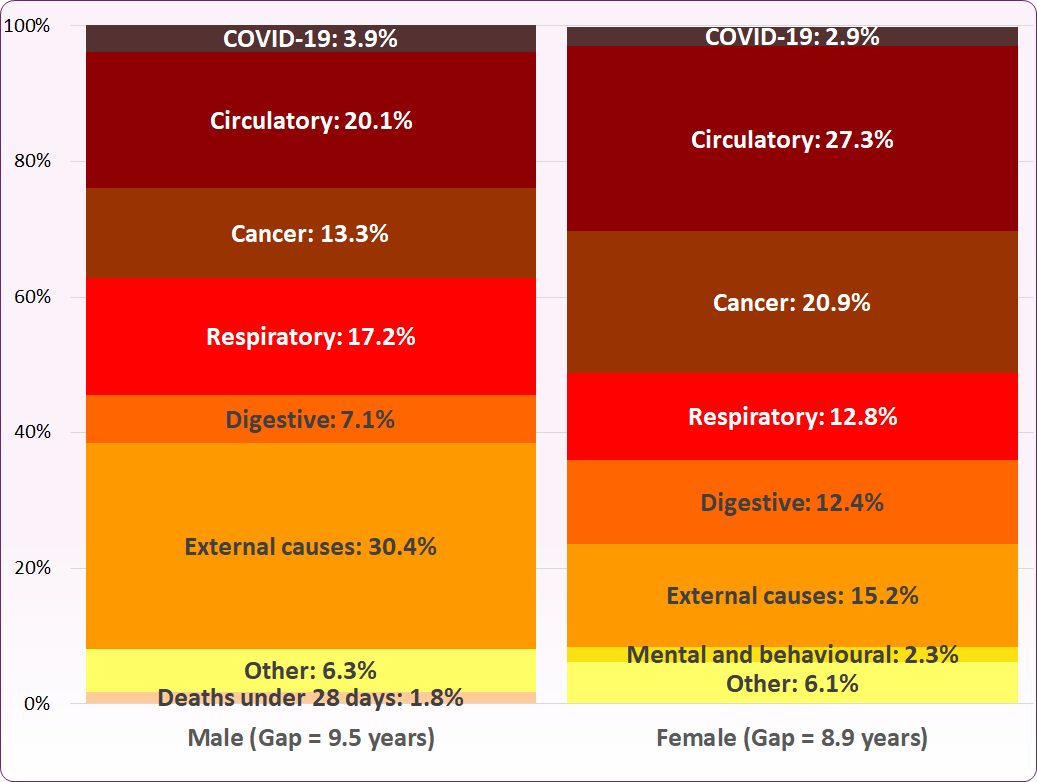 Source: Office for Health Improvement and Disparities (OHID), Segment Tool
Source: Office for Health Improvement and Disparities (OHID), Segment Tool
Figure 9 shows the breakdown of the life expectancy gap between Blackpool as a whole and England as a whole, by cause of death for the period 2020-2021.
For males, mortality from circulatory disease (24.1%), external causes (15.3%), and respiratory diseases are major contributors to the gap in life expectancy between Blackpool and England as a whole. For females, cancer (26.5%), digestive diseases (including alcohol-related conditions) (14.9%), and circulatory diseases (14.7%) are the main contributors.
Figure 9 - Scarf Chart showing the breakdown of the life expectancy gap between Blackpool as a whole and England as a whole, by cause of death, 2020-2021 (provisional)
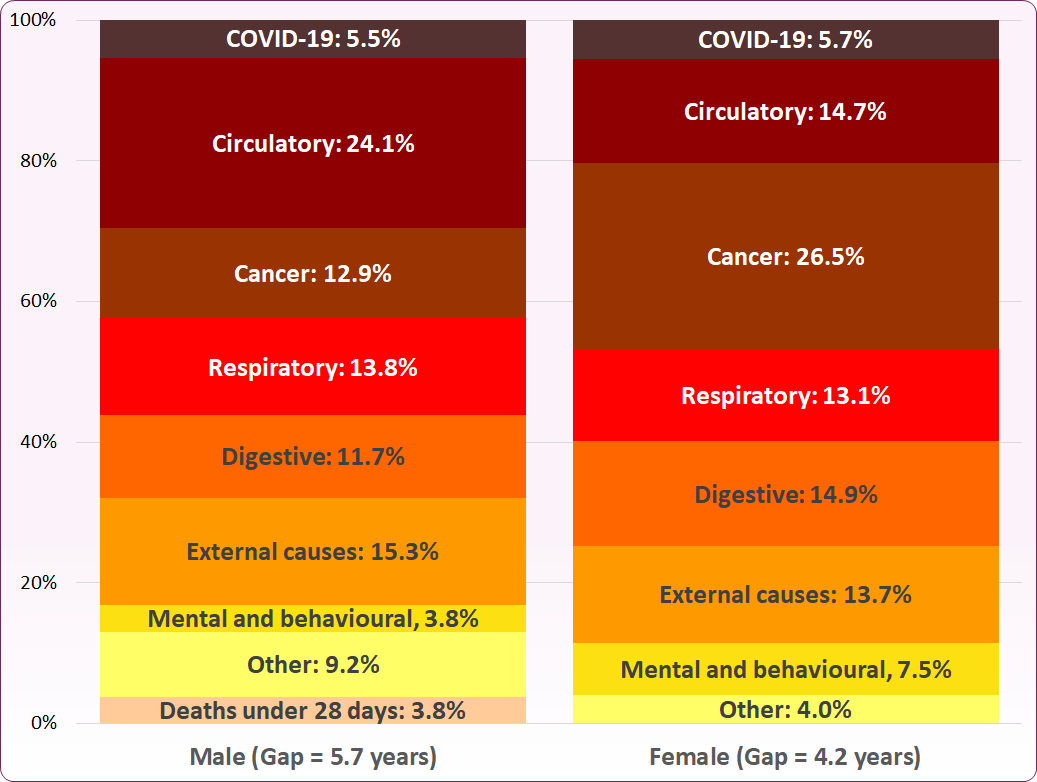
Source: Office for Health Improvement and Disparities (OHID), Segment Tool
The Slope Index of Inequality in life expectancy is an indicator that measures health inequalities within a local area. The measure compares life expectancies between geographic sub-areas that have been ranked by socioeconomic deprivation. Figures 10 and 11 illustrate the change that has occurred over time in the Slope Index of Inequality in both males and females. Those in the most affluent communities within Blackpool saw increased or similar life expectancy between 2010-12 and 2018-20, whilst those in less affluent areas, particularly women, were more likely to see a reduction. The steeper angle of the slope in 2018-20 shows that inequalities of life expectancy between the most and least deprived areas have increased. For further information regarding the Slope Index of Inequality please see:
Guide to the Slope Index of Inequality
Figure 10 - Blackpool - Life Expectancy at Birth by Deprivation Deciles - Males - Slope Analysis
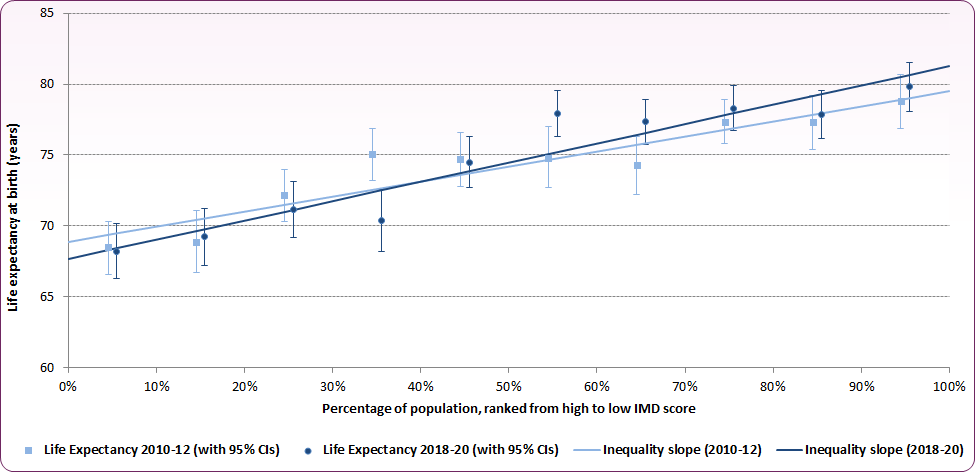 Source: OHID Public Health Profiles / ONS, Life expectancy at birth by deprivation decile, 2010-12 to 2018-20
Source: OHID Public Health Profiles / ONS, Life expectancy at birth by deprivation decile, 2010-12 to 2018-20
Figure 11 - Blackpool - Life Expectancy at Birth by Deprivation Deciles - Females - Slope Analysis
 Source: OHID Public Health Profiles / ONS, Life expectancy at birth by deprivation decile, 2010-12 to 2018-20
Source: OHID Public Health Profiles / ONS, Life expectancy at birth by deprivation decile, 2010-12 to 2018-20
[] Note: The estimated average Healthy Life Expectancy values for individual wards may be lower than those reported due to overall declines in male and female HLE across Blackpool since 2009-13. More up-to-date ward level HLE data is not currently available.